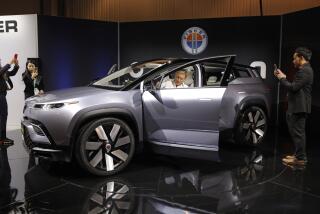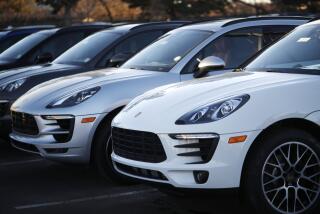Chevy SS and Corvette Stingray Convertible bolster brand’s lineup
These are happy days for the fun side of Chevrolet, as 2013 has been a very good year for the performance division of General Motors’ everyman brand.
The all-new, seventh-generation Corvette went on sale in August to critical and consumer acclaim. The topless version of the C7 started shipping to customers this week, and a fire-breathing Z06 model will debut at the Detroit Auto Show in January. Through November, sales of the Corvette are up 228 percent over the same period in 2012.
Meanwhile, the Camaro got a quick aesthetic update and a new model for the 2014 lineup. Sales so far this year are on track to make 2013 the fourth consecutive year that Chevy’s iconic muscle car is the best-selling sports car in the U.S.
Together with sales of the Corvette, Chevy’s performance division makes up roughly 25 percent of all sports cars sold in the U.S.
Hoping to carry this momentum into the world of sedans, the bow tie brand is adding a third, V-8 go-fast car to the lineup. Chevy recently put on sale the all-new 2014 SS, a full-size, rear-wheel-drive performance sedan that is the company’s first in 17 years.
We recently logged some seat time in the SS and Corvette Stingray Convertible and came away impressed.
Chevy SS
This new Chevy SS picks up where the Pontiac G8 left off in 2009. For two short years, GM saw fit to import the fastest version of the Holden Commodore from Australia under the Pontiac name. Then the American brand died a painful death and the flow of rear-wheel-drive performance sedans from Down Under stopped.
Until now.
To create the SS, GM again turned to its Australian subsidiary. It took the Commodore SS-V Redline, tuned the engine for more power and displacement, and added a host of technology and safety features.
The result is a powerful, composed sedan that starts at $45,770 including destination and a $1,300 gas guzzler tax. It’s a sleeper not only because it can blast from zero to 60 mph in 4.5 seconds (according to Car and Driver), but also because it can carry five very entertained adults in a surprising level of comfort and refinement.
Moving those five happy souls is a 6.2-liter V-8 engine that Chevy also uses in the current Camaro SS and the previous generation Corvette (C6).
For duties in the SS, it’s good for 415 horsepower and 415 pound-feet of torque. Power flows to those rear wheels via a six-speed automatic transmission with paddle shifters.
Though purists may raise a stink about the lack of a manual transmission option, Chevy says that consumers vote with their wallets. Too few people would actually buy this car with a manual to justify the cost of certifying a manual gearbox for use in the U.S. This matters even more on a low-volume performance sedan.
The lack of a DIY shifter is our loss, as a third pedal would really heighten the driver’s connection with this car. The automatic is only decent around town, though its attention picks up noticeably when the gearbox is in Sport mode. It’s then that the transmission’s Performance Mode kicks in, shifting (and not shifting) with surprising prescience.
This gives the V-8 a chance to sing. Don’t be fooled by the 415-horsepower figure; this is a remarkably composed car. Sure, the V-8’s roar bursts from the engine bay when you stand on the gas pedal. But it’s easy, usable power that never gets the car out of sorts, unless that’s your thing.
The rear-drive SS has plenty of neutral grip in hard corners, and a relatively modest curb weight of 3,975 pounds helps the car feel agile, especially for a full-sized sedan.
Yet this isn’t the only reason why the driver and his four charges have plenty to smile about. Chevy has crammed the interior with enough technology and quality materials to make the $46,000 asking price seem like a bargain.
This includes nicely bolstered leather seats that are heated and cooled up front, touchscreen navigation system, suede interior finishes, a backup camera, forward collision warning, blind-spot monitoring, lane-departure warning and eight air bags. The only options available are a sunroof and a full-size spare tire.
Pegging a competitor for this SS is tough; few sedans mix power, performance and price in the same way. The closest peer is the Dodge Charger SRT. Although it’s up on the SS by 55 horsepower, it’s down considerably in refinement and handling.
In this light, Chevy should have no trouble meeting its modest sales expectations. There have to be at least a few thousand buyers a year on our shores who will be seduced by this car’s easy power and below-the-radar luxury. Besides, we can’t let Australia have all the fun.
Corvette Stingray Convertible
For just $5,000 more than the $52,000 base price of the Corvette Stingray, you get the same ferocious V-8, supremely capable handling and sublime refinement. Now with easier access to sunlight.
In our first drive of the Stingray convertible, we detected no sacrifices in performance or feel over the hardtop version. That’s high praise, as building a high-performance convertible that handles as its coupe brethren is harder than you’d think.
The roof is a crucial structural component of a car. When an automaker hacks it off, it needs to add structural rigidity elsewhere to keep the car from bending like a wet noodle when driven hard. This adds weight, and often still isn’t enough to keep the drop-top version as rigid. Yet Corvette engineers had an easier time with the conversation. Remember that all Stingray coupes have a removable hardtop, so the car’s architecture was designed from the ground up to include stiffness elsewhere.
All the engineers had to add was a modest 64 pounds of motor for the roof mechanism.
Save for atrocious rear visibility out the pinhole of a rear window, this is one of the best convertibles available.
The 6.2-liter V-8 engine still has power for days, regardless of which gear you’ve selected. Horsepower rates at 455 and the torque at 460 pound-feet, with each of those numbers jumping up by five if you add the $1,195 performance exhaust system. And why not? If you’re going to have a cookie, have a cookie.
Same with the $2,800 Z51 performance pack on the model we tested. For this modest sum, it adds a performance suspension, an electronic limited slip differential, additional cooling, and bigger brakes and tires.
Our model also had the new seven-speed manual transmission. Unchanged from the coupe variant, this clutch is easy to use while modulating the car’s considerable power. Again, our only gripe was the narrow spacing that made it easy to shift to seventh gear when you were looking for fifth.
The thickly padded roof holds all wind at bay and raises or lowers in 21 seconds. New for this generation of Corvette convertible is the ability to operate the roof when the car is moving up to 30 mph.
Other goodies on the Corvette we drove included carbon fiber trim, a multi-mode exhaust and a touchscreen navigation system. Out the door, our arctic white tester — with an interior lined in blood-red leather — sells for $69,975.
With the top down, a pleasant conversation is certainly possible, as the wind doesn’t intrude into the cockpit egregiously. You sit low in the cabin, coddled by the redesigned interior, and look out over the seductively long and chiseled hood.
Then the light turns green, you stomp on the go pedal, and wonder why anyone would bother spending six figures on a convertible.
david.undercoffler@latimes.com
Twitter @latimes_driven







